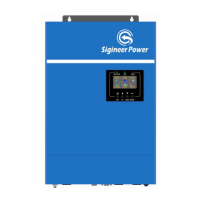Equalization function is added into the M series inverter charge controller. It reverses the buildup of
negative chemical effects like stratification, a condition where acid concentration is greater at the bottom of
the battery than at the top. Equalization also helps to remove sulfate crystals that might have built up on the
plates. If left unchecked, this condition, called sulfation, will reduce the overall capacity of the battery.
Therefore, it’s recommended to equalize battery periodically.
How to Apply Equalization Function
You must enable battery equalization function in monitoring LCD setting program 43 first. Then, you may
apply this function in device by either one of following methods:
1. Setting equalization interval in program 47.
2. Active equalization immediately in program 48.
When to Equalize
In float stage, when the setting equalization interval (battery equalization cycle) is arrived, or equalization is
active immediately, the controller will start to enter Equalize stage.
Equalize charging time and timeout
In Equalize stage, the controller will supply power to charge battery as much as possible until battery
voltage raises to battery equalization voltage. Then, constant-voltage regulation is applied to maintain
battery voltage at the battery equalization voltage. The battery will remain in the Equalize stage until setting
battery equalized time is arrived.
However, in Equalize stage, when battery equalized time is expired and battery voltage doesn’t rise to
battery equalization voltage point, the charge controller will extend the battery equalized time until battery
voltage achieves battery equalization voltage. If battery voltage is still lower than battery equalization
voltage when battery equalized timeout setting is over, the charge controller will stop equalization and return
to float stage.
The M Series pure sine wave inverter/charger is built with MPPT solar charging modules up to 100A.

